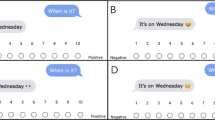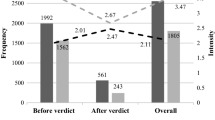Abstract
This study examines the relationship between emoticons and emotions, specifically, exploring the roles of emoticons on emotional representativeness, awareness and management. This study hypothesizes that the combination of text and emoticons has the greatest effect on emotion representativeness, awareness and management. Also, the effect of emoticons is moderated by the users’ emotions. A 3 (emotions: joy/fear/sadness) × 3 (message patterns: using emoticons only/using text only/emoticons plus text) factorial experimental design was adopted in this study. 154 participants were recruited from a private college in Hong Kong and they were randomly assigned to one of the nine conditions. The results showed that there was no significant main effect of message patterns on emotional representativeness, awareness and management. The main effect of emotions was only significant for emotional management. The interaction effects between emotions and message patterns were also insignificant. This study provides some new insights to understand the roles of emoticons in expressing emotions in Instant Messenger.
Access this chapter
Tax calculation will be finalised at checkout
Purchases are for personal use only
Similar content being viewed by others
References
Bowlby, J. (1991). Postscript. In C. M. Parkes, J. Stevenson-Hinde, & P. Marris (Eds.), Attachment across the life cycle (pp. 293–297). London: Routledge.
Burgoon, J. K., & Hoobler, G. (2002). Nonverbal signals. In M. L. Knapp & J. Daly (Eds.), Handbook of interpersonal communication (pp. 240–299). Thousand Oaks, CA: Sage.
Derks, D., Bos, A. E. R., & von Grumbkow, J. (2007). Emoticons and social interaction on the Internet: The importance of social context. Computers in Human Behavior, 23, 842–849.
Derks, D., Bos, A. E. R., & von Grumbkow, J. (2008a). Emoticons in CMC: Social motives and social context. CyberPsychology & Behavior, 11(1), 99–101.
Derks, D., Fischer, A. H., & Bos, A. E. R. (2008b). The role of emotion in computer-mediated communication: A review. Computers in Human Behavior, 24(3), 766–785.
Ekman, P. (1965). Differential communication of affect by head and body cues. Journal of Personality and Social Psychology, 2, 726–735.
Fredrickson, B. L. (2013). Positive emotions broaden and build. In P. Devine & A. Plant (Eds.), Advances in experimental social psychology (Vol. 47, pp. 1–53). Burlington: Academic Press.
Garnefski, N., & Kraaij, V. (2006). Cognitive emotion regulation questionnaire—Development of a short 18-item version (CERQ-short). Personality and Individual Differences, 41, 1045–1053.
Greenberg, L. S. (2004). Emotion-focused therapy. Clinical Psychology and Psychotherapy, 11, 3–16.
Greenberg, L. S., & Paivio, S. C. (1997). Working with the emotions in psychotherapy. New York: Guilford Press.
Hasson, G. (2012). Brilliant communication skills. Great Britain: Pearson Education.
Hogenboom, A., Bal, D., Frasincar, F., Bal, N., De Jong, F., & Kaymak, U. (2015). Exploiting emoticons in polarity classification of text. Journal of Web Engineering, 14(1), 22–40.
Huang, A. H., Yen, D. C., & Zhang, X. (2008). Exploring the potential effects of emoticons. Information & Management, 45, 466–473.
Huffaker, D. A., & Calvert S. L. (2005). Gender, identity, and language use in teenage blogs. Journal of Computer-Mediated Communication, 10(2). Retrieved from http://jcmc.indiana.edu/vol10/issue2/huffaker.html
Izard, C. E. (1990). Facial expressions and the regulation of emotions. Journal of Personality and Social Psychology, 58(3), 487–498.
Jenson, S. (2005). Default thinking: Why consumer products fail. In R. Harper, A. Taylor, & L. Palen (Eds.), The inside text: Social perspectives on SMS in the mobile age (pp. 305–325). London: Kluwer.
Kato, S., Kato, Y., & Scott, D. (2009). Relationships between emotional states and emoticons in mobile phone email communication in japan. International Journal on E-Learning, 8(3), 385–401.
Lee, V., & Wagner, H. (2002). The effect of social presence on the facial and verbal expression of emotion and the interrelationships among emotion components. Journal of Nonverbal Behavior, 26(1), 3–25.
Luor, T., Lu, H. P., Wu, L. L., & Tao, Y. H. (2010). The effect of emoticon in simplex and complex task-oriented communication—An empirical study of instant messaging. Computers in Human Behavior, 26(5), 889–895.
Mennin, D. S. (2005). Emotion and the acceptance based approaches to the anxiety disorders. In S. M. Orsillo & L. Roemer (Eds.), Acceptance and mindfulness-based approaches to anxiety: Conceptualization and treatment (pp. 37–68). Berlin: Springer.
O’Dowd, R., & Ritter, M. (2006). Understanding and working with ‘failed communication’ in telecollaborative exchanges. CALICO journal, 623–642.
Reid, S. C., Kauer, S. D., Hearps, S. J. C., Crooke, A. H. D., Khor, A. S., Sanci, L. A., et al. (2011). A mobile phone application for the assessment and management of youth mental health problems in primary care: A randomized controlled trial. BMC Family Practice, 12(131), 1–13.
Rice, R. E., & Love, G. (1987). Electronic emotion: Socioemotional content in a computer-mediated network. Communication Research, 14, 85–108.
Salló, S. (2011). The faces of messenger emoticons in the virtual communication. Acta Universitatis Sapientiae: Social Analysis, 2(1), 307–332.
Silvia, P. J. (2002). Self-awareness and emotional intensity. Cognition and Emotion, 16, 195–216.
Tetteroo, D. (2008, June 23). Communicating emotions in instant messaging, an overview. Retrieved from http://referaat.cs.utwente.nl/conference/9/paper/6909/communicating-emotions-in-instant-messaging-an-overview.pdf
Thelwall, M., Buckley, K., Paltoglou, G., Cai, D., & Kappas, A. (2010). Sentiment strength detection in short informal text. Journal of the American Society for Information Science and Technology, 61(12), 2544–2558.
The Radicati Group. (2013). Email statistics report, 2013–2017. Retrieved from http://www.radicati.com/
Tossell, C. C., Kortum, P., Shepard, C., Barg, L. H., Rahmati, A., & Zhong, L. (2012). A longitudinal study of emoticon use in text messaging from smartphones. Computers in Human Behavior, 28, 659–663.
Walther, J. B., & D’Addario, K. P. (2001). The impacts of emoticons on message interpretation in computer-mediated communication. Social Science Computer Review, 19(3), 324–347.
Wang, W., Zhau, Y., Qiu, L., & Zhu, Y. (2014). Effects of emoticons on the acceptance of negative feedback in computer-mediated communication. Journal of the Association for Information Systems, 15(8), 454–483.
Author information
Authors and Affiliations
Corresponding author
Editor information
Editors and Affiliations
Rights and permissions
Copyright information
© 2017 Springer Nature Singapore Pte Ltd.
About this paper
Cite this paper
Lau, WY., Chan, CK. (2017). Emoticons and Emotions: Exploring the Roles of Emoticons in Emotional Representativeness, Awareness and Management. In: Ma, W., Chan, CK., Tong, Kw., Fung, H., Fong, C. (eds) New Ecology for Education — Communication X Learning. Springer, Singapore. https://doi.org/10.1007/978-981-10-4346-8_17
Download citation
DOI: https://doi.org/10.1007/978-981-10-4346-8_17
Published:
Publisher Name: Springer, Singapore
Print ISBN: 978-981-10-4345-1
Online ISBN: 978-981-10-4346-8
eBook Packages: EducationEducation (R0)




